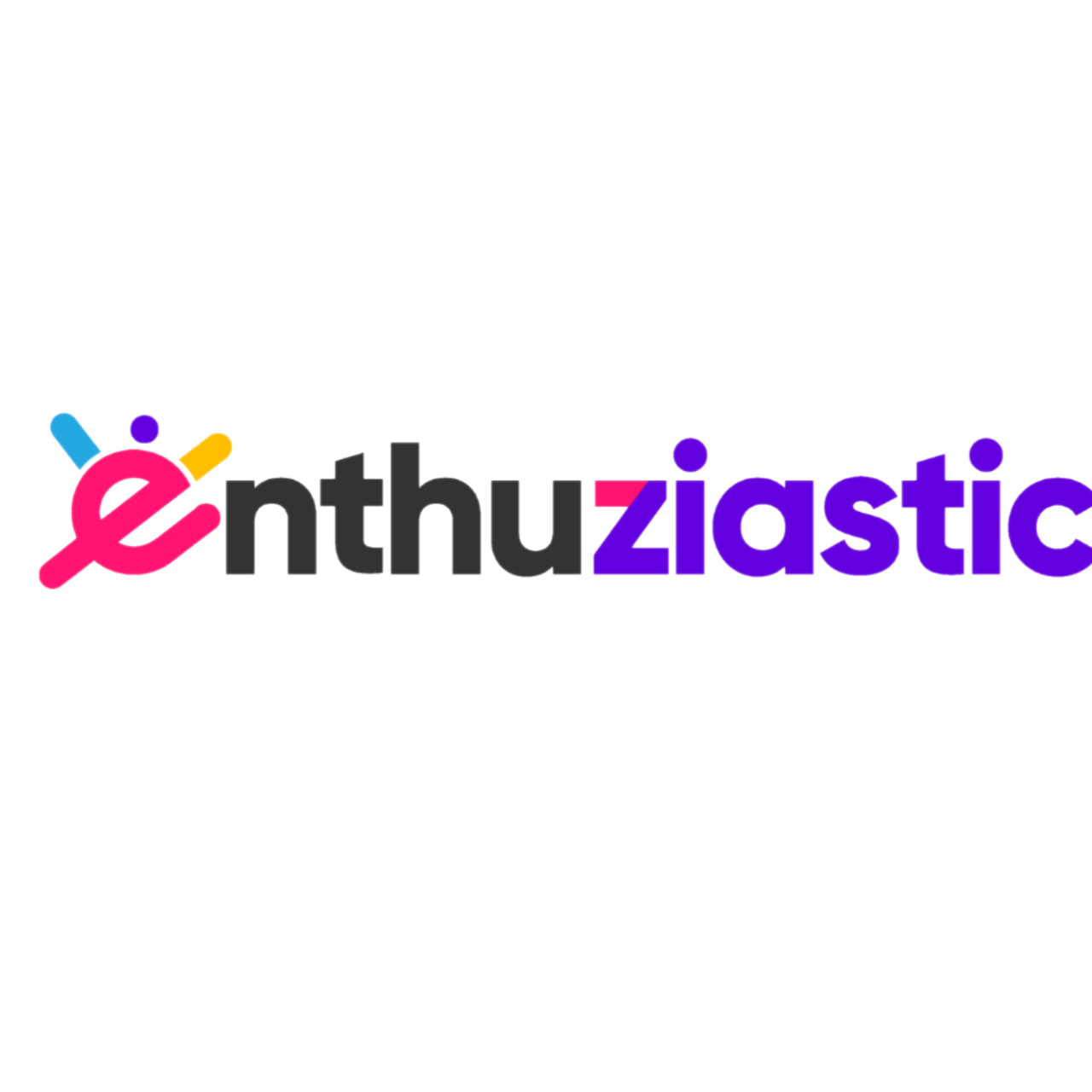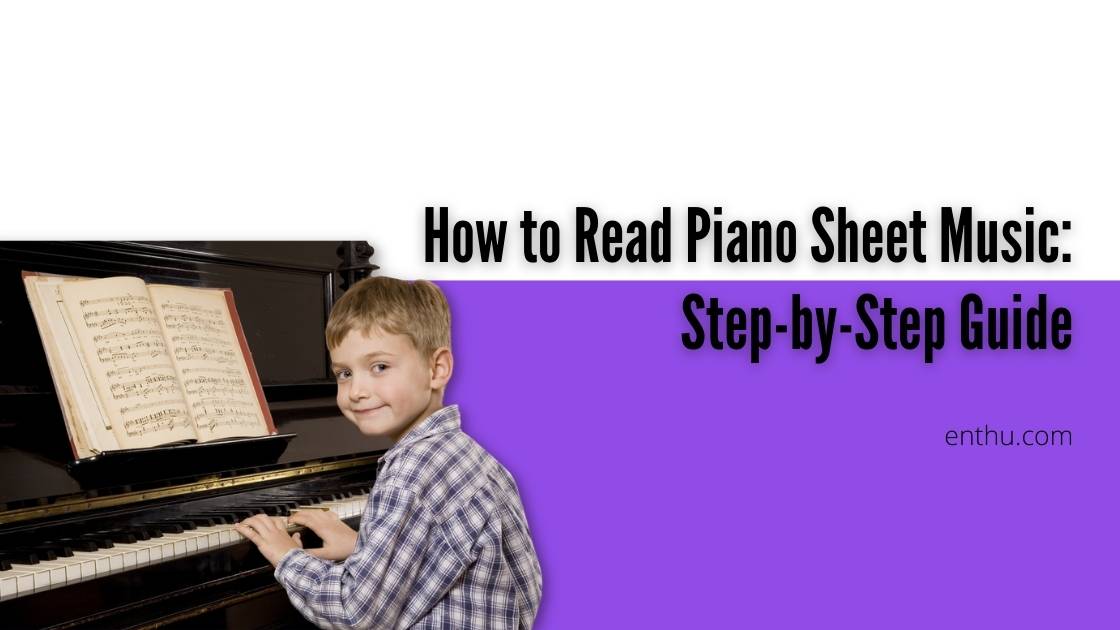What is your ultimate dream?
Well, when I began my piano learning journey, all I wanted was to play on stage one day. I dreamt of playing with both hands without looking down at the keys.
I wanted to play like professional pianists, uninterrupted and confident.
If you have a similar dream, I have a tip for you. Learn how to read piano sheet music. Trust me, it will make everything easier.
Introduction to Piano Sheet Music [All You Need to Know]
Many beginners rush to learn how to read piano sheet music without knowing what it is. I think shooting an arrow in the dark is not a good idea. So, before we move forward, let’s take a look at what is sheet music in piano learning.
What is Sheet Music in Piano Learning?
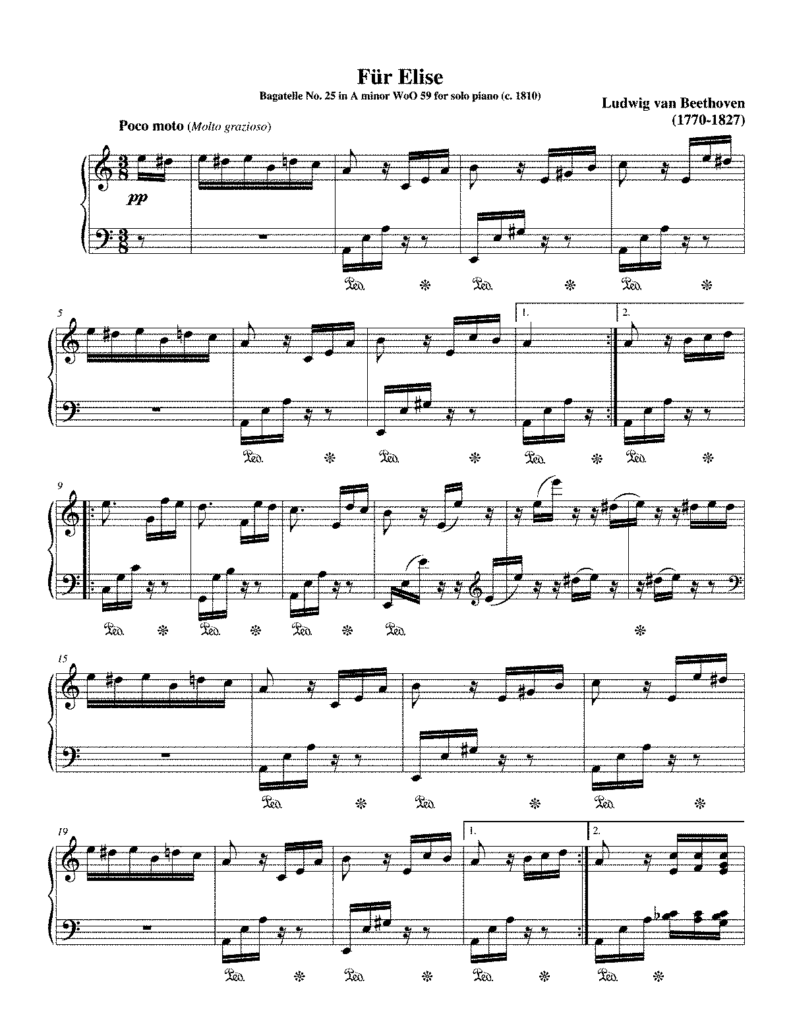
Sheet music is a musical notation written down or printed on paper using various symbols to indicate the rhythms, pitches, or chords of a song or instrumental musical piece.
Here’s a sheet music for you. It’s Beethoven’s Fur Elise written down using musical notation. You can also checkout this video on reading musical notation.
Types of Sheet Music
- Full Score: It’s a large book containing the music of all instruments or voices in a composition in a fixed order. The size of a full score remains large enough for a conductor to be able to read when directing an orchestra or an opera performance/rehearsals.
A full score can be a miniature score, a study score, or a piano score. - Piano-vocal Score: A piano-vocal score (or simply vocal score) is the reduced version of the full score, focusing on the vocal parts and the piano parts (usually for two hands) underneath the vocal parts.
- Lead Sheet: A lead sheet is a type of sheet music that focuses only on the melody, lyrics, and harmony, using one staff with chord symbols placed above and lyrics below.
It’s primarily used in popular music and jazz to capture a song’s essential elements without getting into the details of performing the song. - Chord Chart: A chord chart or chart provides basic harmonic information without displaying any melodic information at all.
There are chord charts that indicate the rhythm that should be played. - Tablature: A tablature (or tab) is a type of sheet music that shows where to play the pitches on an instrument rather than which pitches to produce. It includes rhythm indicated as well.
This type of sheet music is typically written/printed for a solo instrument. - Fake Book: A fake book is a collection of jazz songs and tunes consisting of the basic elements of particular music.
There are generally two types of fake books. One, the collections of lead sheets that include the melody, chords, and lyrics. Second, the collections of songs and tunes with only the chords.
How to Read Piano Sheet Music?
Get Familiar with the Symbols
If you look at any sheet music, you will see there are many symbols. Those symbols are either the staff, the clefs, or the notes. Any type of sheet music contains these fundamental components, even piano music.
The answer to how to read piano sheet music also lies with the symbols of musical notation. You must know which symbol stands for what to learn to read music effortlessly.
So, let’s get started.
1. Staff
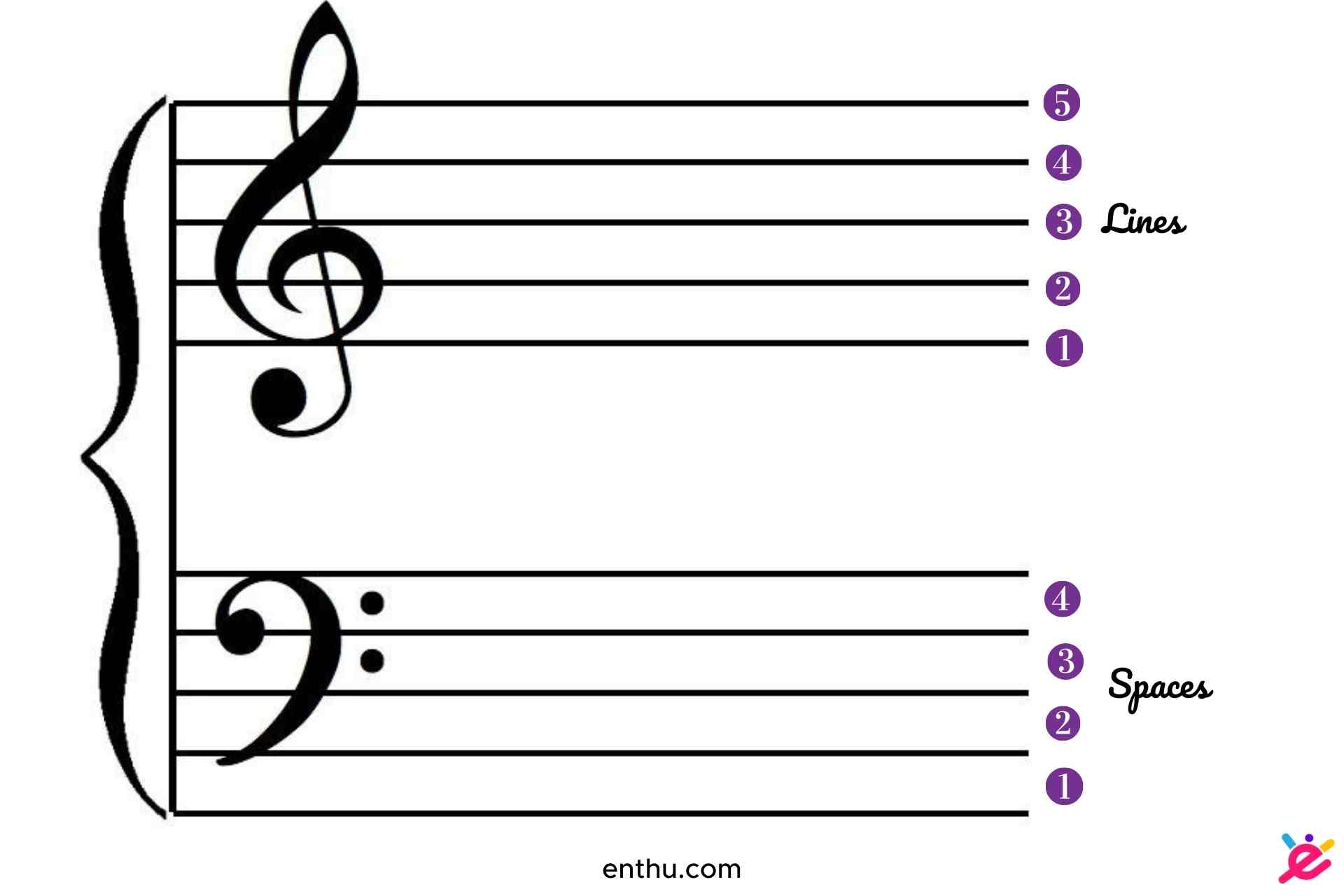
The staff in musical notation is made of five lines and four spaces. Look at the above picture to understand that every staff has five lines and four spaces. Remember, every line and space in the staff represents a different letter that represents a note.
The notes, represented by lines and spaces, are namely A, B, C, D, E, F, and G. Remember, the sequence of the notes ascend up the staff alphabetically.
2. Clef
There are four types of clef in musical notation, but only two types are used in piano sheet music. They are treble clef and bass clef.
What is Treble Clef?
The staff (in the below picture) with the symbol of flipped cursive s on the left side is the treble clef. The main feature of the treble clef is that its semi-circle-like rounded tail encircles the “G” line on the staff.
Generally, the higher notes on the piano/keyboard are notated on the treble clef. It is also used to write the notes of instruments with a higher pitch, such as a flute, violin, or saxophone.
Beginners often find it hard to remember the notes represented by the lines and spaces of the treble clef. So, I suggest memorizing the mnemonics to make it easier.
Use EGBDF to remember the lines. EGBDF stands for “Every Good Boy Does Fine” as you can see in the above image. Therefore, the notes names of the lines from the down to up are E, G, B, D, and F.
To remember the spaces, use FACE. The note names of the space are F, A, C, and E.
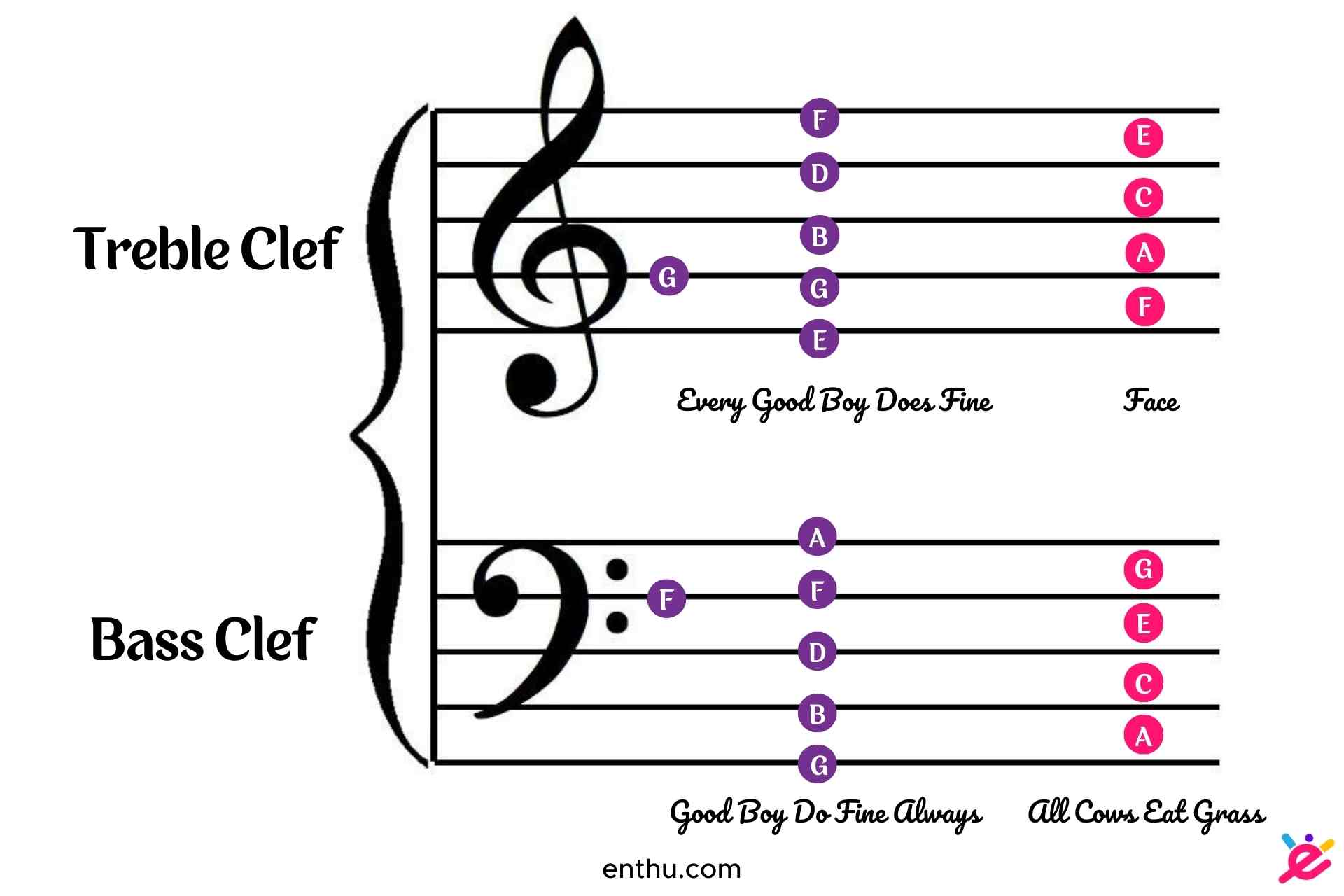
What is Bass Clef?
The staff with the symbol of inverted comma (❜) on the left side with two dots (like a colon) on its back is the bass clef. The distinct feature of the bass clef is that the line passing between the two dots is always the “F” line.
It is also referred as the “F” clef.
The lower notes on the piano/keyboard are notated on the bass clef. It is also used to write the notes of the instruments that come with a lower pitch, such as the bassoon, tuba, or the cello.
Like the treble clef, it can also be hard to remember the notes represented by the lines and spaces of the bass clef. Therefore, I suggest memorizing the mnemonics to make it easier.
Use “Good Boys Do Fine Always” to remember the lines. The notes names of the lines from the down to up are G, B, D, F, and A, respectively.
To remember the spaces, use “All Cows Eat Grass.”. The note names of the space are A, C, E, and G.
Wondering how to draw Bass Clefs?
Check out What are Bass Clef Notes? to know everything you need to know about Bass Clefs.
3. Grand Staff
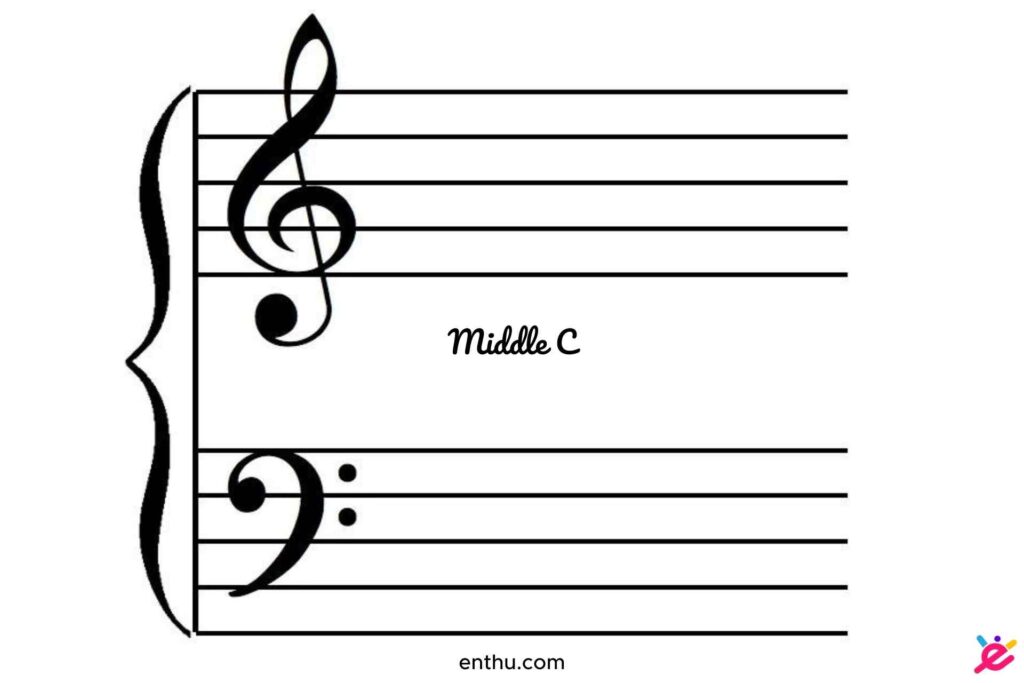
The grand staff comes with two staves connected by a brace on the left. The staves are of 5 lines and 4 spaces each.
While the top staff is generally marked with a treble clef, the bottom staff is marked with a bass clef.
Remember that the top staff is typically played with the right hand, and the bottom staff is played with the left hand.
Just as the middle C is always the center point on the keyboard/piano, so it is on the staff. Therefore, middle C lies on an imaginary line in the gap between the staves. For reference, please look at the above picture.
Find out the meaning of the Bracket in the Grand Staff
Read the Grand Staff in Piano to learn everything about it.
4. Notes

The piano notes written on the staff indicate which note to play on the piano and how long to play it. There are three parts to a note. They are the note head, the stem, and the flag.
Note Heads
The note heads are either filled or open. Take a look at the picture; the black-headed notes are the filled ones, and the white-headed notes are the open ones.
When the note heads sit above or below the five lines and four spaces of staff, a line is drawn through the note, indicating the note letter to play. That line is called the ledger line.
Note Stem
The note stem is a line extending either up or down from the note head. When the line is pointing upwards, it extends from the right. Similarly, when it’s pointing downwards, it always extends from the left. Please note that the direction of the line isn’t saying anything about how to play the note. It’s just to make the notes easier to read.
Note Flag
The note flag is the curvy mark to the right of the note stem. The purpose of a note flag is to tell you how long to play a note.
What are the Values of Notes?
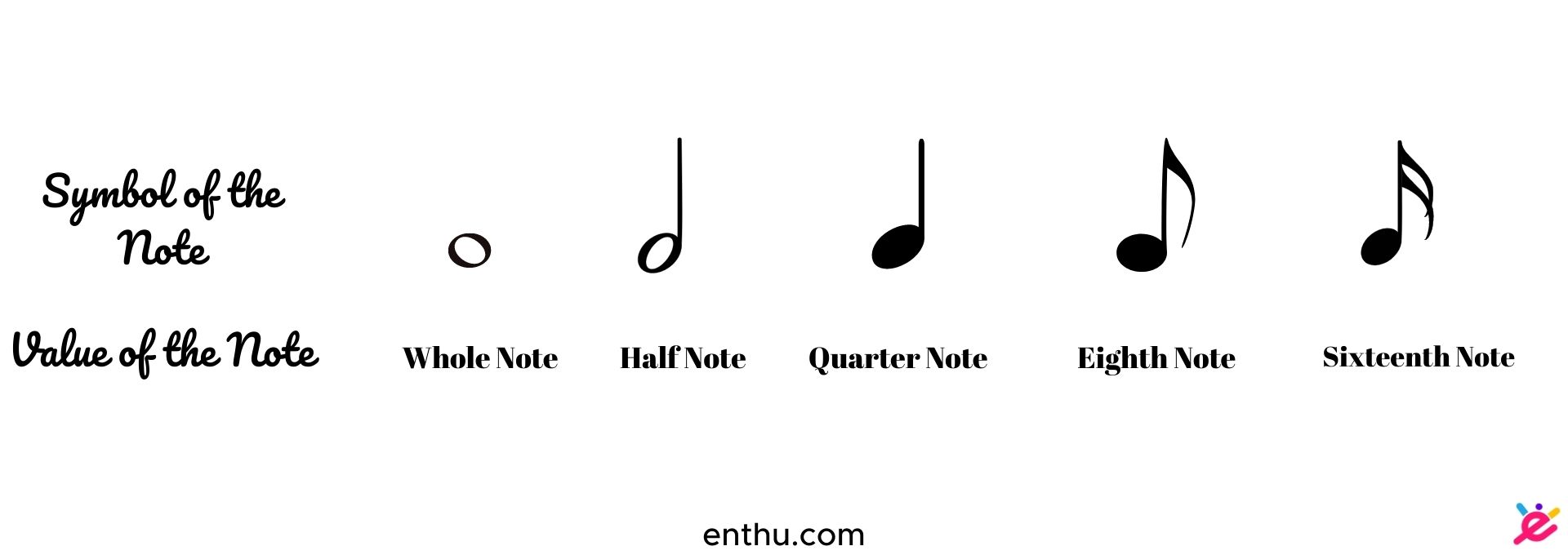
If it’s an open note like an “O” without a stem, then it’s a whole note. It gets four beats. If it’s an open note head with a stem-like the one in the above picture, then it is a half note, and it gets two beats.
A closed note head with a stem is called a quarter note, and it gets one beat. A closed note head with a stem and a note flag is the eighth note. A similar note but with two flags is the sixteenth note.

Take a look at the above picture to understand basic note calculation. 1 whole note is equal to 2 half notes, 2 half notes are equal to 4 quarter notes, which is equal to 8 eighth notes, and 8 eighth notes is equal to 16 sixteenth notes.
Keep reading to know more about the relationship between notes and beats.
Learn what is Whole Rest & Half Rest and its relation to Piano Notes
Read Piano Notes 101: A Simple Guide to learn everything about it.
How Dots & Ties Change Notes’ Values?
A dot after the note head, as shown in the below picture, changes its value. It adds another half of that note’s duration to it.
Therefore, a full note with a dot is one-and-half note, and a half note with a dot is equal to a half note and a quarter note.
 A tie is a curve above the notes, as shown in the picture. When there’s a wave-like that above two notes, then it means both the notes are tied.
A tie is a curve above the notes, as shown in the picture. When there’s a wave-like that above two notes, then it means both the notes are tied.
When playing the piano, two tied notes should be held as long as the value of both the notes together.
Ties are commonly used in musical notation to signify held notes that cross measures or bars (as you can see in the above picture).
Here’s another picture to understand the dots and ties.
A half note with a dot is equal to a tied half note and a quarter note. Again, a half note with two dots is equal to a tied half note, a quarter note, and an eighth note.
Just keep in mind that the dot halves the value of a note.
How Flags & Beams Change Notes’ Values?

Let’s say flags and beams are used to write faster notes.
As you already read above, a flag halves the value of a note. So, if there’s a flag on a quarter note, then it signifies 1/2 of the quarter note. If there’s a double flag on the quarter note, then it halves that to 1/4 of the quarter note.
Beams are used for the same reason and to keep the sheet neater. Take a look at the below picture to understand.
5. Beat, Meter & Time Signature
Have you noticed how we tap our feet on the ground every time we hear music? Or clap in a particular rhythm in a concert?
Well, that’s what a beat is. We tap our foot or clap following beats, right? While playing music, that beat is called meter, and in written music or sheet music, that meter becomes a song’s time signature.
Interestingly, the time signature (or meter) of a music piece/song is represented in fractions on the sheet. Therefore, it always has a top number and a bottom number.
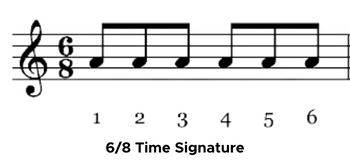
Before I tell you what the top and bottom numbers mean, let me tell you about a bar and a measure.
A bar line is a vertical line you can see in the below picture, and the space between two bars (vertical lines) is called a measure.
 The top number in a time signature tells you how many beats are in a measure, and the bottom number tells you the note value (the length) of each beat.
The top number in a time signature tells you how many beats are in a measure, and the bottom number tells you the note value (the length) of each beat.
For instance, the 6/8 time signature picture, 6 is the number of beats, and 8 is the note value of each beat. Similarly, in the above picture, 4 is the number of beats and 4 is also the note value of each beat.
Learn more about 6/8 Time Signature
Check out The Beginners Guide to time Signature to find out.
Learn the Tempo Math
What is Tempo in sheet music?
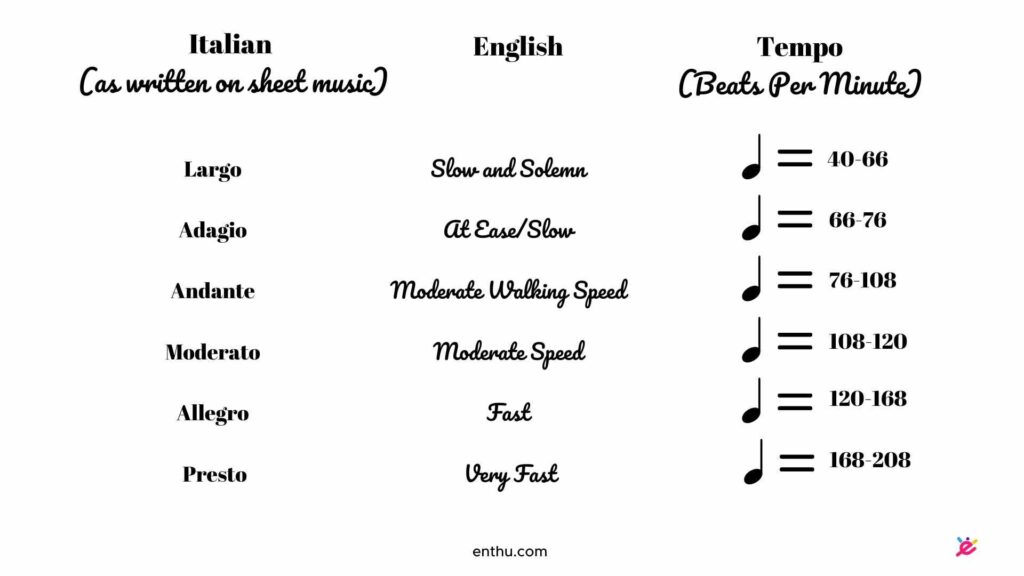
Tempo in sheet music tells you how fast or slow a piece is intended to be played. It’s defined by the beats per minute. Generally, it’s shown at the top of the sheet.
As you can see in the picture, a tempo of 60 BPM (beats per minute) means you need to play 60 of the signified notes every minute. In other words, a single note every second.
Similarly, if the tempo is 120, then you need to double your speed to play 2 single notes every second, making it 120 signified notes every minute.
Some of the common words to represent tempo on the sheet are “Largo,” “Adiago”, “Moderato”, “Allegro,” or “Presto”. Check out the above image to learn the meanings of these words.
Also, there’s an instrument called metronome that musicians use to keep tempo while practicing a new piece.
You are almost done with the basic of reading music sheet if have read the above material. Next, you need to know about piano scales, and you’re ready to ace reading musical notation.
FAQs
Is reading music notation essential in the music industry?
Even though it’s not mandatory to learn music notation, it’s recommended. Without the knowledge of how to read sheet music, it can be difficult to identify which parts are played by which instruments during rehearsals or performances. In addition, not knowing how to read notation often leads performers astray when trying to play by ear.
Especially, if you’re a budding pianist, I suggest you learn to read musical notation as soon as possible.
Conclusion
If you know the symbols for staff, grand staff, clefs, notes, etc. your job’s half done. As beginners, that is all you need to know about sheet music.
Next, I suggest continuing your piano lessons seriously till you graduate to intermediate level or expert level. For now, I recommend practicing easy piano songs by reading sheet music.
Learn Piano From Expert Teachers
